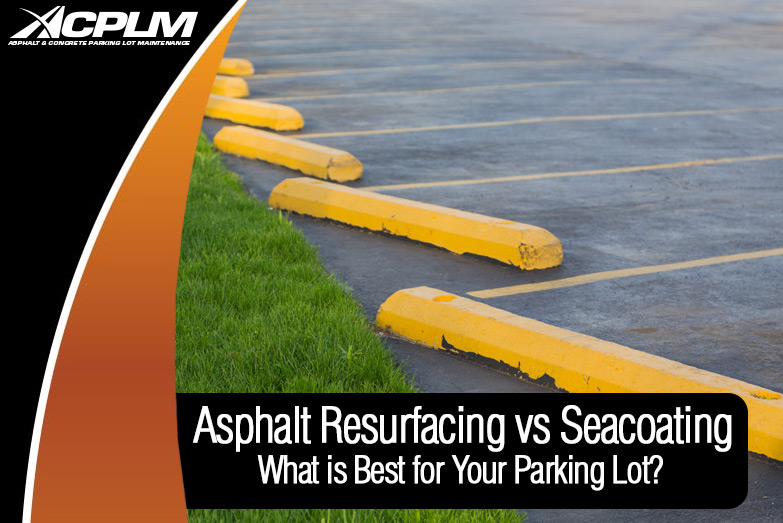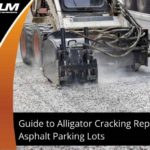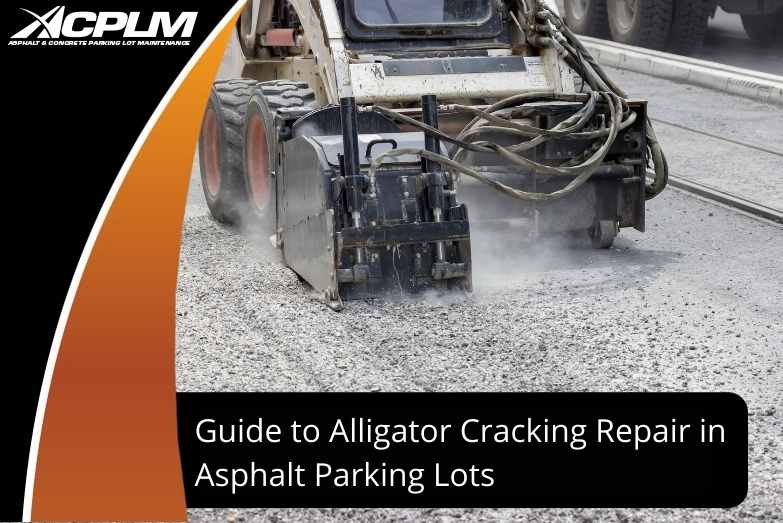
What’s Best for Your Parking Lot in Tampa Bay?
If your parking lot is starting to show signs of wear, it’s time to consider your options for restoring it. Two of the most common asphalt maintenance techniques are asphalt resurfacing and sealcoating, but they serve very different purposes. While both can enhance the appearance of your lot, knowing the difference between them is essential to avoid wasting money, or worse, putting off a more serious issue.
In this guide, we’ll break down the pros, cons, and use cases for each method so you can make the right choice for your property.
Key Insights
- Asphalt resurfacing is a cost-effective way to restore structural integrity by applying a new asphalt layer over a deteriorating surface.
- Sealcoating is a protective treatment that extends the life of asphalt by shielding it from UV rays, water, oil, and chemical spills.
- Resurfacing is typically needed every 10–15 years, while sealcoating should be done every 3–5 years for ongoing protection.
- Use resurfacing if your parking lot has alligator cracks, uneven surfaces, or multiple repairs.
- Choose sealcoating as part of your preventative maintenance routine to keep a healthy surface looking fresh and resilient.
- A professional inspection is crucial to determine whether your asphalt issues are surface-level or structural.
Understanding Asphalt Resurfacing
Asphalt resurfacing involves applying a new layer of hot asphalt over an existing pavement structure. Also known as an “overlay,” this process is ideal when your parking lot has extensive surface damage but still has a solid foundation underneath.
When to Resurface:
- Widespread cracking (such as alligator cracks)
- Surface erosion or fading due to aging
- Uneven or sunken spots
- Multiple pothole patches
Resurfacing doesn’t require tearing out the entire lot, which makes it more cost-effective than a full replacement. However, it’s not a solution for lots with base failure, poor drainage, or foundational damage. If the subgrade is compromised, the overlay will quickly crack and fail.
Benefits of Asphalt Resurfacing:
- Restores a smooth, even driving surface
- Extends the life of your parking lot by 8–15 years
- Enhances property appearance and curb appeal
- More affordable than full replacement
- Adds a fresh layer of durability
Limitations:
- Not a solution for structural or drainage issues
- More expensive than sealcoating
- Should only be performed when underlying conditions are stable
Understanding Sealcoating
Sealcoating is a surface-level maintenance technique that applies a thin layer of protective sealant over asphalt. This sealant defends against UV rays, oil spills, moisture infiltration, and oxidation, some of the leading causes of early asphalt degradation.
While sealcoating doesn’t repair significant damage, it acts like sunscreen for your pavement. It protects and extends the life of your investment when applied regularly.
When to Sealcoat:
- Every 3–5 years after initial installation or resurfacing
- When asphalt is still structurally sound
- As part of a regular preventative maintenance plan
Benefits of Sealcoating:
- Protects against UV, water, oil, and chemical damage
- Prevents small cracks from expanding
- Slows oxidation and aging of the asphalt
- Enhances appearance with a rich, black finish
- Very cost-effective when done regularly
Limitations:
- Does not fix deep cracks, potholes, or foundation issues
- Can’t restore structural integrity
- Must be applied under proper weather conditions
Choosing Between Resurfacing and Sealcoating
The best way to decide between resurfacing and sealcoating is to assess the condition of your parking lot and consider your long-term goals.
| Feature | Asphalt Resurfacing | Sealcoating |
|---|---|---|
| Purpose | Structural restoration | Surface protection |
| Frequency | Every 10–15 years (as needed) | Every 3–5 years |
| Cost | Higher than sealcoating | Low-cost maintenance |
| Addressed Issues | Cracks, potholes, rough texture | Fading, oxidation, minor cracks |
| Best For | Aging lots with surface damage | Well-maintained lots or after resurfacing |
| Lifespan Extension | Adds 8–15 years | Adds 2–4 years per application |
Rule of Thumb:
- Sealcoat if your lot is in good to fair condition and you want to preserve its appearance and durability.
- Resurface if your lot has major cracking or surface distress, but the base is still intact.
Why Regular Maintenance Matters
Without regular maintenance, even the most well-constructed asphalt lots will deteriorate over time. Rain, oil, gasoline, UV rays, and heavy traffic wear down asphalt slowly, leading to cracks, fading, and erosion.
By combining regular sealcoating with timely resurfacing, you can maximize the lifespan of your parking lot and reduce the need for full reconstruction, which is the most costly option.
Common Mistakes Property Owners Make
- Waiting too long to resurface, allowing cracks to worsen and damage the subgrade
- Using sealcoating as a fix instead of a preventive measure
- Not consulting a professional to assess underlying issues
- Skipping maintenance entirely and shortening the lifespan of the lot
If you’re unsure about the current state of your asphalt, it’s time to bring in an expert for evaluation.
FAQs About Asphalt Resurfacing and Sealcoating
What is the main difference between asphalt resurfacing and sealcoating?
Asphalt resurfacing adds a new layer of hot asphalt on top of the surface to restore structural integrity and smoothness. Sealcoating, on the other hand, applies a protective sealant to defend against weather, UV rays, and oils without adding any structural strength.
How often should I resurface my parking lot?
Typically, every 10 to 15 years, but only if the foundation is still stable. If the sub-base is failing, resurfacing won’t help, and full replacement may be needed.
How often should I sealcoat my parking lot?
Most professionals recommend sealcoating every 3 to 5 years, depending on traffic volume and weather conditions. For high-traffic areas, more frequent applications may be required.
Can I sealcoat instead of resurfacing?
No. Sealcoating is a preventative measure, not a structural repair. If your lot has major cracks, potholes, or uneven surfaces, resurfacing or replacement will be necessary before sealcoating can be effective.
Will asphalt resurfacing fix all cracks and potholes?
It will fix surface-level issues but not deeper structural problems. Before resurfacing, contractors will usually patch and repair the worst areas, but resurfacing cannot fix a failing base.
How do I know if my asphalt needs resurfacing or just sealcoating?
A professional inspection is the best way to evaluate this. In general:
- Small cracks and fading = Sealcoating
- Widespread cracking and uneven surfaces = Resurfacing
Schedule a Professional Asphalt Inspection Today with ACPLM
If you’re not sure whether your parking lot needs asphalt resurfacing or sealcoating, the professionals at ACPLM are here to help. With over 50 years of experience in asphalt paving, maintenance, and repair across Tampa Bay, we’ll evaluate your lot and recommend the most cost-effective, long-term solution.
Don’t wait until damage gets worse. Call ACPLM today at 888-959-9637 for a free consultation and keep your parking lot looking, and performing, its best for years to come.






